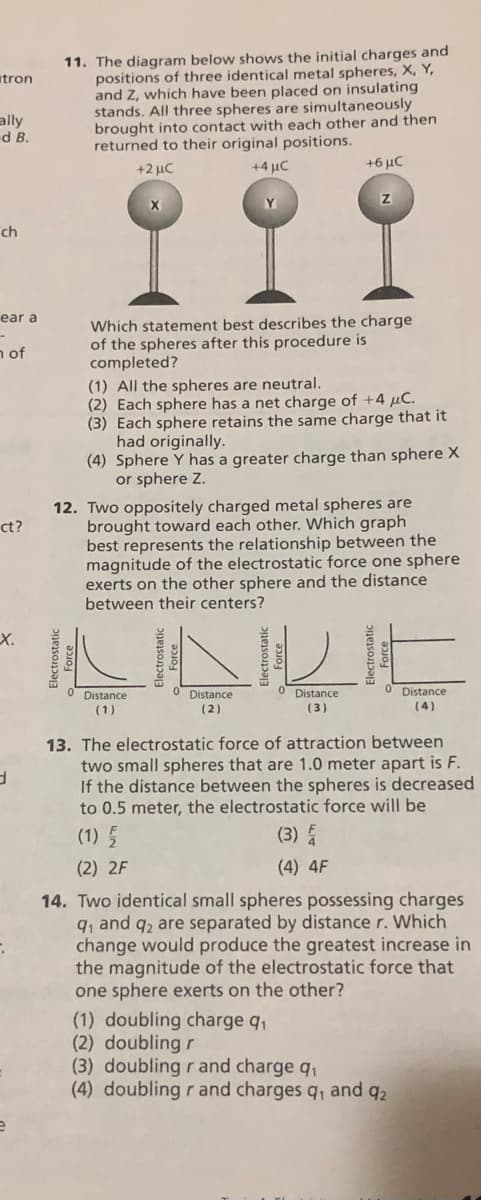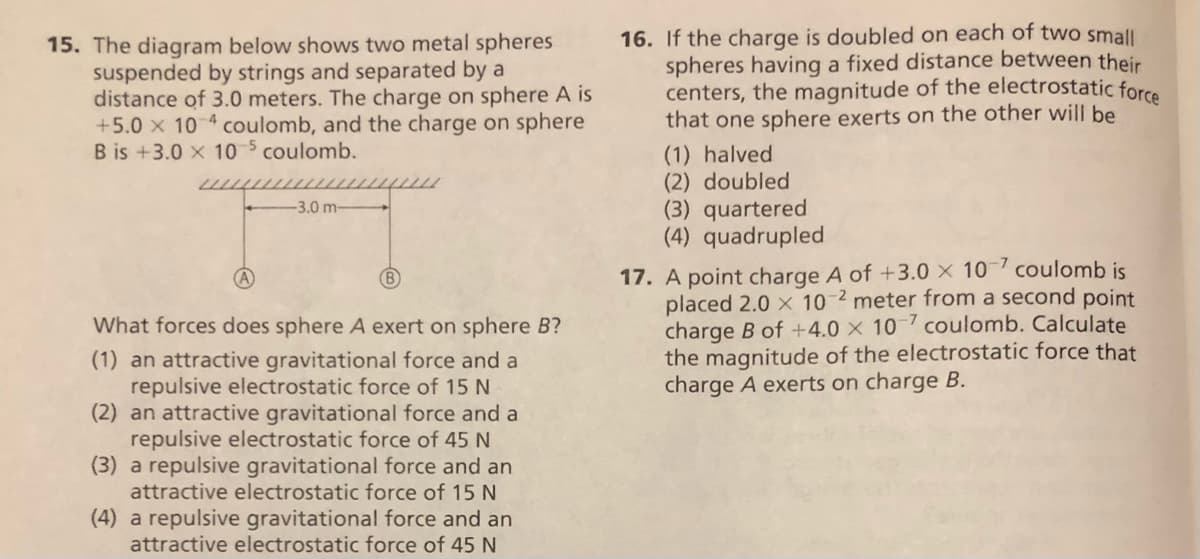- The diagram below shows the initial charges and positions of three identical metal spheres, X, Y, and Z, which have been placed on insulating stands. All three spheres are simultaneously brought into contact with each other and then returned to their original positions. +2 uC +4 με +6 µC Y. Which statement best describes the charge of the spheres after this procedure is completed? (1) All the spheres are neutral. (2) Each sphere has a net charge of +4 uµć. (3) Each sphere retains the same charge that it had originally. (4) Sphere Y has a greater charge than sphere X or sphere Z.
- The diagram below shows the initial charges and positions of three identical metal spheres, X, Y, and Z, which have been placed on insulating stands. All three spheres are simultaneously brought into contact with each other and then returned to their original positions. +2 uC +4 με +6 µC Y. Which statement best describes the charge of the spheres after this procedure is completed? (1) All the spheres are neutral. (2) Each sphere has a net charge of +4 uµć. (3) Each sphere retains the same charge that it had originally. (4) Sphere Y has a greater charge than sphere X or sphere Z.
College Physics
1st Edition
ISBN:9781938168000
Author:Paul Peter Urone, Roger Hinrichs
Publisher:Paul Peter Urone, Roger Hinrichs
Chapter18: Electric Charge And Electric Field
Section: Chapter Questions
Problem 9CQ: Figure 18.43 shows the charge distribution in a water molecule, which is called a polar molecule...
Related questions
Question
please help with questions 11,12,13,14,15,16, and 17 all together please i’m so stressed please please

Transcribed Image Text:11. The diagram below shows the initial charges and
positions of three identical metal spheres, X, Y,
and Z, which have been placed on insulating
stands. All three spheres are simultaneously
brought into contact with each other and then
returned to their original positions.
tron
ally
d B.
+2 µC
+4 μC
+6 με
ch
ear a
Which statement best describes the charge
of the spheres after this procedure is
completed?
n of
(1) All the spheres are neutral.
(2) Each sphere has a net charge of +4 µC.
(3) Each sphere retains the same charge that it
had originally.
(4) Sphere Y has a greater charge than sphere X
or sphere Z.
12. Two oppositely charged metal spheres are
brought toward each other. Which graph
best represents the relationship between the
magnitude of the electrostatic force one sphere
exerts on the other sphere and the distance
between their centers?
ct?
ILIN
х.
Distance
Distance
Distance
O Distance
(1)
(2)
(3)
(4)
13. The electrostatic force of attraction between
two small spheres that are 1.0 meter apart is F.
If the distance between the spheres is decreased
to 0.5 meter, the electrostatic force will be
(1) 5
(3)
(2) 2F
(4) 4F
14. Two identical small spheres possessing charges
9, and q2 are separated by distance r. Which
change would produce the greatest increase in
the magnitude of the electrostatic force that
one sphere exerts on the other?
(1) doubling charge q,
(2) doubling r
(3) doubling r and charge q,
(4) doubling r and charges q, and q2
Electrostatic
Force
Electrostatic
Force

Transcribed Image Text:15. The diagram below shows two metal spheres
suspended by strings and separated by a
distance of 3.0 meters. The charge on sphere A is
+5.0 x 10 4 coulomb, and the charge on sphere
B is +3.0 x 10 coulomb.
16. If the charge is doubled on each of two small
spheres having a fixed distance between their
centers, the magnitude of the electrostatic force
that one sphere exerts on the other willI be
(1) halved
(2) doubled
(3) quartered
(4) quadrupled
-3.0 m-
17. A point charge A of +3.0 x 10-7 coulomb is
placed 2.0 x 10 2 meter from a second point
charge B of +4.0 × 10 7 coulomb. Calculate
the magnitude of the electrostatic force that
charge A exerts on charge B.
B)
What forces does sphere A exert on sphere B?
(1) an attractive gravitational force and a
repulsive electrostatic force of 15 N
(2) an attractive gravitational force and a
repulsive electrostatic force of 45 N
(3) a repulsive gravitational force and an
attractive electrostatic force of 15 N
(4) a repulsive gravitational force and an
attractive electrostatic force of 45 N
Expert Solution
This question has been solved!
Explore an expertly crafted, step-by-step solution for a thorough understanding of key concepts.
This is a popular solution!
Trending now
This is a popular solution!
Step by step
Solved in 2 steps

Knowledge Booster
Learn more about
Need a deep-dive on the concept behind this application? Look no further. Learn more about this topic, physics and related others by exploring similar questions and additional content below.Recommended textbooks for you

College Physics
Physics
ISBN:
9781938168000
Author:
Paul Peter Urone, Roger Hinrichs
Publisher:
OpenStax College

Physics for Scientists and Engineers
Physics
ISBN:
9781337553278
Author:
Raymond A. Serway, John W. Jewett
Publisher:
Cengage Learning

Physics for Scientists and Engineers with Modern …
Physics
ISBN:
9781337553292
Author:
Raymond A. Serway, John W. Jewett
Publisher:
Cengage Learning

College Physics
Physics
ISBN:
9781938168000
Author:
Paul Peter Urone, Roger Hinrichs
Publisher:
OpenStax College

Physics for Scientists and Engineers
Physics
ISBN:
9781337553278
Author:
Raymond A. Serway, John W. Jewett
Publisher:
Cengage Learning

Physics for Scientists and Engineers with Modern …
Physics
ISBN:
9781337553292
Author:
Raymond A. Serway, John W. Jewett
Publisher:
Cengage Learning

Physics for Scientists and Engineers, Technology …
Physics
ISBN:
9781305116399
Author:
Raymond A. Serway, John W. Jewett
Publisher:
Cengage Learning

Physics for Scientists and Engineers: Foundations…
Physics
ISBN:
9781133939146
Author:
Katz, Debora M.
Publisher:
Cengage Learning

Glencoe Physics: Principles and Problems, Student…
Physics
ISBN:
9780078807213
Author:
Paul W. Zitzewitz
Publisher:
Glencoe/McGraw-Hill